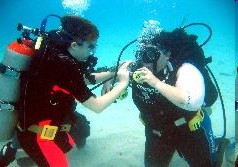Any basic SCUBA class will tell you that the primary consideration when buying gear is fit. If it does not fit right, it will not function properly. The best example is the simple SCUBA mask. If it does not fit, it will leak, and fill with water. This not only defeats the purpose, but also adds a great deal of stress to the diver. Make sure your gear fits!
After fit, here are some other considerations you may want to keep in mind when making gear selection.
Intended use: Ask yourself a serious question: what type of diving will you be doing in 5 years? Your SCUBA gear will easily last that long. I still regularly dive the first SCUBA regulator I ever bought. Many fall victim of short sighted purchases. Then every few years, they sell all their gear, and buy gear that is better suited to the diving they are doing now.
Marketing claims: The newest or most expensive model is not always the best choice. Manufacturers are constantly trying to separate themselves from the others. Inflatable Water Slide There have not been huge changes in SCUBA technology in the last few years. Improvements in manufacturing practices have reduced the cost to make the gear, and exotic materials have made some of the gear more rugged. However, despite marketing claims, the basic function of the gear has not changed significantly.
Local Conditions: Ask a few local divers, or instructors, what type of gear they use and why. There are a few pitfalls to this approach. If their answer is one of the following, “it was a deal”, “someone else recommended it” or “That’s what our shop sells”, then look for another source. Keep in mind that shops recommend what they sell. That does not mean its the right gear for your local diving. Check out the diving experience of the shop owner (the one who purchases the gear). Make sure their diving matches your plans. If not, then the gear may not be suited to your diving conditions.
A good instructor will usually be upfront, but some are affiliated with a shop, and will promote the shop’s gear. Experienced divers will get the right gear for the job. Find out what it is and why.
Shop for features not brands: When talking with other divers, ask about the features they look for in the gear. During these discussions, leave the brand out of it. Most brands offer similar features. Or put another way, the features you’re looking for are probably available from several brands. The important part is to determine which features are important, and which are not. Some features, highly touted by the marketing types, may be a detriment in your diving conditions. Make a list of the features you want before stepping into the shop.
Which brand: Again, most features are available from several brands. How do we choose? Without going into the Chevy vs Ford issue, here are a few points to ponder:
- Service: Some brands provide fantastic gear, but have very few locations for service.
- Quality: Some brands have better manufacturing processes, and produce gear with better fit and finish.
- Reliability: This often has to do with the quality of the materials used in the gear, and the quality of the engineering that went into it. Simple is usually more reliable.
Price: Why is this last on my list? Simple, if you have not chosen good gear, then getting a good deal, is no deal at all. I hope the above discussions will prevent you from purchasing the wrong gear, or falling for the marketing claims and purchasing unnecessary bells and whistles. If you can avoid those pitfalls, then you should have saved enough money to buy the right gear once.
 This is a another common question along with: How do you learn to dive? How long does it take?
This is a another common question along with: How do you learn to dive? How long does it take?